India grows bananas as one of its most important fruit crops. Area-wise, it ranks only second and first in production in this country after mango. With an annual output of approximately 16.820 mt, India leads the world in banana production. Bananas are so prevalent and popular in India that the rich and poor enjoy them. Due to the availability of fruits throughout the year, unlike other seasonal tree fruits, it has become a necessity in any household in India.
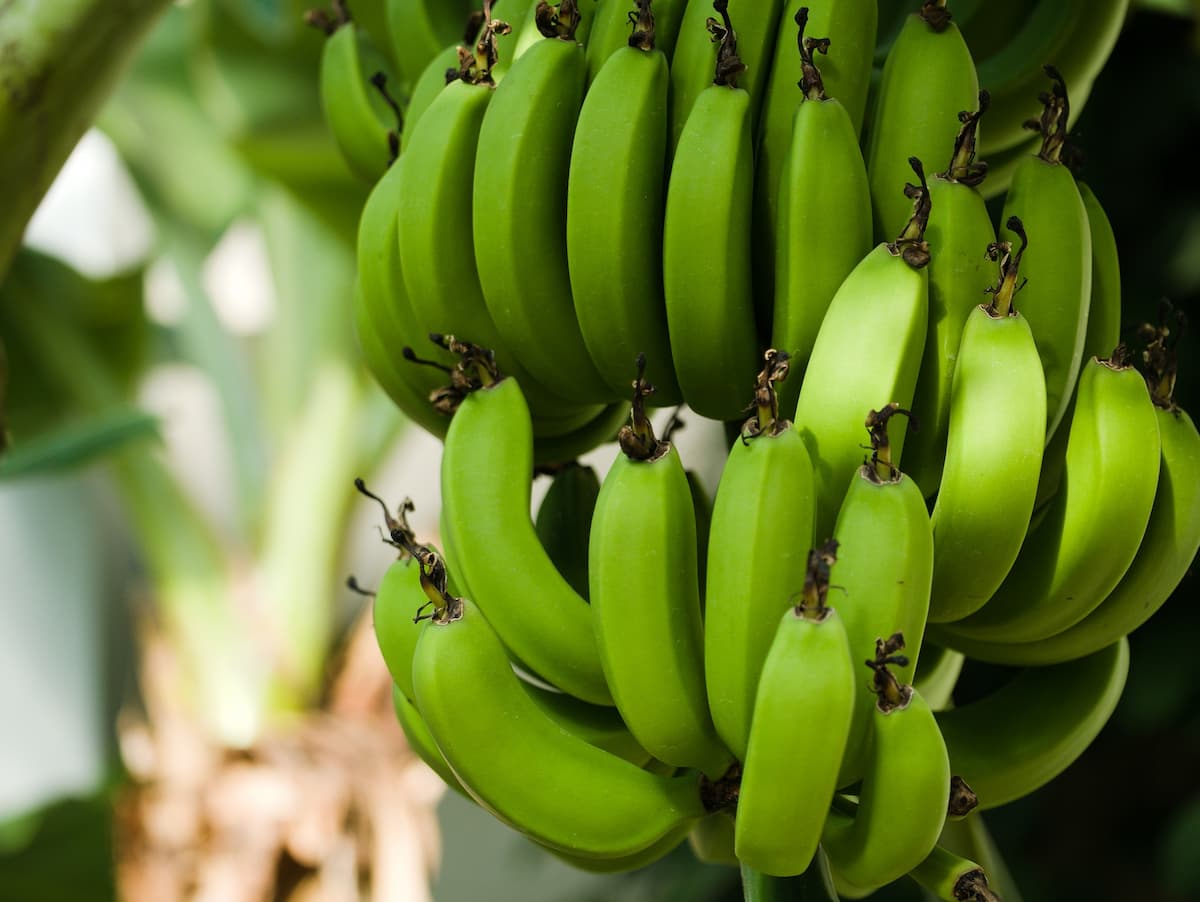
Therefore, banana cultivation is the most popular agricultural practice in India. The Robusta variety is also known as Morris. It is mostly grown in Tamil Nadu and Karnataka for table use. This variety is also grown in Andhra Pradesh and Maharashtra. With well-developed fruits, it produces high yields and large sizes.
Depending on the ripening conditions, dark green fruits turn bright yellow. There is a good aroma to the fruit, and it is very sweet. The bunch weighs about 25-30 kg. It requires propping. It is not suitable for long-distance transportation due to its poor keeping quality and quick breakdown of pulp after ripening. The Sigatoka leaf spot disease highly affects Robusta in humid tropics.
Robusta banana farming in India
Characteristics of Robusta banana
- Plants are medium-sized, with stems dark purple with a greenish tinge.
- Bunch – drooping, 7-9 hands per bunch, 12-15 fingers per hand. Average 100
- fruits per bunch, 25-30 kg.
- Fruits – large, skin medium-thick, ripe fruits drop off easily, fruits – green to dull yellow, pulp – sweet, juicy, agreeable flower, better-keeping quality than Dwarf Cavendish.
- Susceptible to leaf spot, corm weevil, rhizome rot, and mosaic diseases.
- Crop duration – 12 to 14 months
- The fruit has a poor keeping quality leading to a quick breakdown of pulp after ripening, hence not suited for long-distance transportation.
- The banana that retains its green color even after ripening comes from a dwarf variety of banana plants.
Soil for Robusta banana cultivation
For banana cultivation to be successful, the soil must be fertile, as bananas are heavy feeders. Bananas also have a restricted root zone, which makes them unique among fruits. Therefore, banana soil should be selected based on its depth and drainage. The soil must be rich, well-drained, fertile, moisture-retentive, and organically rich for bananas. It is recommended that the pH range be between 6.5 and 7.5. The best soils for banana cultivation are alluvial and volcanic.
Various soil types are used to grow bananas in India, including heavy clay soils of the Cauvery delta, alluvial soils of the Gangetic delta, black loams in Maharashtra, coastal sandy loams, and red lateritic soil in Kerala’s hilly tracts. Bananas are famously grown in these areas. The cultivation of bananas is not suitable for saline, solid, and calcareous soils. Bananas need to grow in soils that are neither too acidic nor too alkaline, rich in organic matter, phosphorus-replete, and high in potassium.
In case you missed it: How to Start Green Apple Farming in India: A Production Guide to Planting to Harvesting
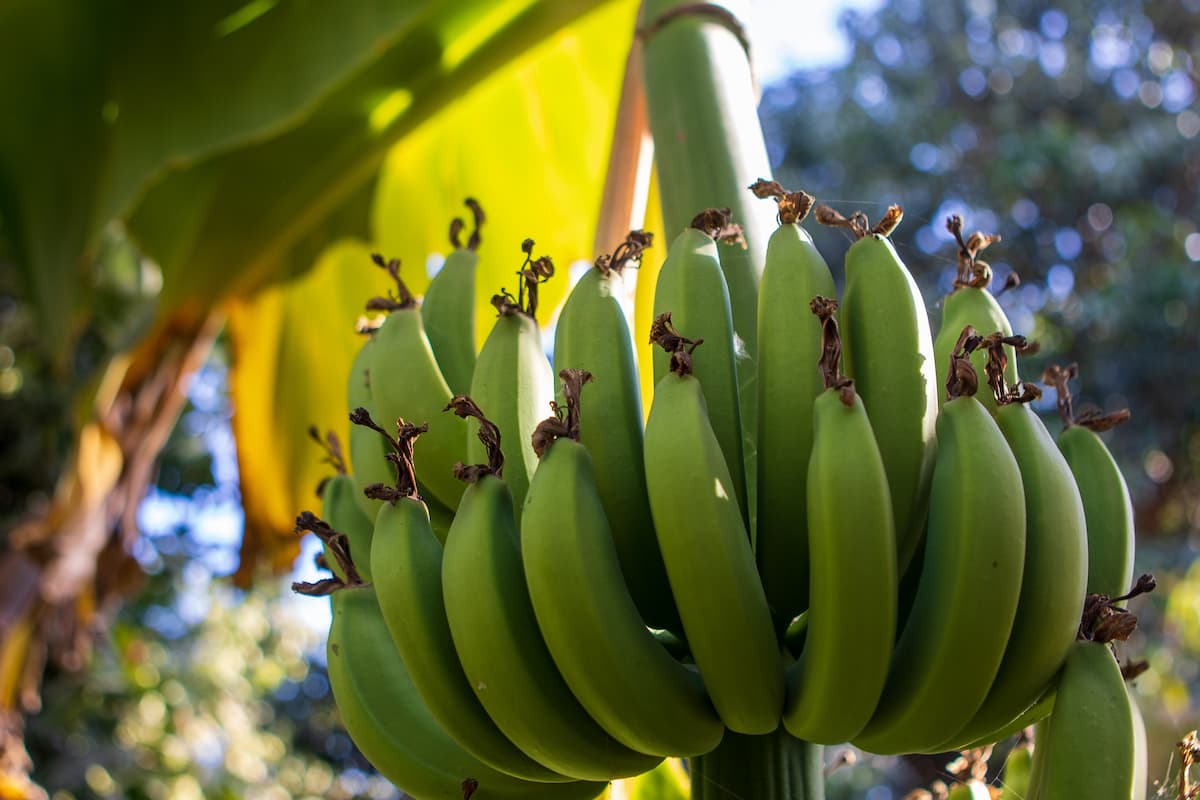
Agro-climatic requirements for Robusta banana
A tropical banana grows well at temperatures between 15°C and 35°C with a relative humidity of 75-85%. It grows from sea level to 2000 meters above mean sea level in humid tropical lowlands. Selecting the right varieties will allow you to cultivate this crop in humid tropical climates to mild subtropical.
Injuries caused by chilling occur when the temperature falls below 12°C. Crops are damaged by winds that exceed 80 km/hr. For bananas to grow vigorously, they need four months of monsoon rainfall (June to September), an average of 650-750 mm. The cultivation of bananas at higher altitudes is limited to a few varieties, such as the “Hill banana.”
Field preparation for Robusta banana crop
- Plant green manure crops before planting bananas, such as daincha and cowpea, and plowing the field four to six times and allowing it to weather for two weeks before planting is recommended.
- For the soil to be tilted finely, the soil must be broken up by rotavators or harrows. As part of soil preparation, FYM is added in a basal dose (about 50 tonnes/ha. before the last harrowing). Then, a laser leveler or blade harrow is used to level the field.
- The land looks leveled using a laser leveler, regardless of wide topographic variations, wide variability in crop yields, and improved water distribution and nutrient use efficiency.
- The pit size should be 45cm x 45cm x 45cm in most cases. In the pits, topsoil will be mixed with 10 kg of FYM (well decomposed), 250 grams of Neem cake, and 20 grams of Carbofuran.
- Nematicides and fumigants are applied to pits before planting in areas with nematode problems.
- Solar radiation is used in prepared pits to kill harmful insects, inhibit soil-borne diseases, and aerate the soil.
- It is recommended that pit mixtures containing saline-alkali soils have organic matter incorporated. When organic matter is added, salinity is reduced, while porosity and aeration are improved.
- Planting in furrows is an alternative to planting in pits. Various methods and depths at which plants can be planted depend on the soil strata.
- Wetlands and hilly areas need not be prepared, and pits are dug directly in the required spacing. Banana cultivation in Hill involves cleaning the jungle and constructing contoured stone walls.
- A minimum of 0.6 m x 0.6 m x 0.6 m pits can be dug at planting points at the plow furrow intersection, extending the field’s length and width.
- In Dwarf Cavendish, two plants per hole at 1.8 x 1.8m spacing doubled yield with little or no effect on bunch size and maturity time.
- Double planting increased returns in Robusta bananas as well.
Selection and pre-treatment of Robusta banana suckers
Choose sword suckers that weigh 1.5 to 2.0 kg and are free from diseases and nematodes. The root system and decayed part of the corm should be trimmed, the pseudostem should be cut, leaving 20 cm from the corm, and the suckers should be graded to size. Carbofuran 3 G granules are used in pralinage with 40 g of granules per sucker. Dip the corm in the mixture using a slurry solution of four parts clay and five parts water and sprinkle Carbofuran on it to control nematodes.
The corm can also be dipped in 0.75% Monocrotophos, shade dried for at least 24 hours, and planted afterward. Sunhemp should be sown on the 45th day and incorporated after about one month. As a result of this operation, nematodes are reduced in number. Therefore, it would be best to use tissue-cultured banana plants with five to six leaves. Apply 25 grams per plant of Pseudomonas fluorescence when planting.
Planting Robusta banana crop
Planting can be done between May and June or between September and October. In small pits taken in the center, a sucker is planted upright with a pseudostem 5 cm above soil level. It is important to press the soil around the sucker to ensure no hollow air spaces. A tissue culture pit is planted with tissue culture plants at ground level.
Planting should be done without damaging the roots by removing the poly cover. Following planting, light irrigation is recommended. It is best to provide partial shade as soon as possible after planting. Except for severe winters and heavy rains when the soil remains very wet, bananas can be planted throughout the year.
No. of plants required per acre:
| Cultivar | Spacing (m) | No. of Suckers Per acre |
| ‘Robusta’ (Harichal) | 1.8 x 1.8 | 1232 |
Nutrition
The banana requires a lot of nutrients, which are often only partially supplied by the soil. The nutrient requirements (determined in India) are 10 kg FYM, 200 – 250 grams of N, 60 – 70 grams of P, and 300 grams of K. On average, bananas require around 7-8 kg of N, 0.7-1.5 kg of P, and 17-20 kg of K. Urea is traditionally used more than phosphorus and potassium by farmers. The area is administered in three or four split doses.
- The top dressing should contain about 100 grams of N per plant, divided into three equal doses 60, 90, and 120 days after planting. During planting, 100 grams of potash and 40 grams of phosphorus must also be applied.
- It is recommended that a full dose of P and K be applied at planting and N in three equal doses in shallow rings about 8-10 cm deep.
- Due to its role in vital functions, potassium plays an essential role in banana cultivation. Hence, continuous supplies are needed for finger-filling.
- The interaction of calcium with N, P, and K increases yield. As soil amendments, dolomite (Mg2CO3) and limestone (CaCO3) are commonly used in acidic soils.
- Foliar application of Mg SO4 is effective in treating acute magnesium deficiencies.
In case you missed it: How to Start Alphonso Mango Farming in India: A Cultivation Guide to Planting to Harvesting
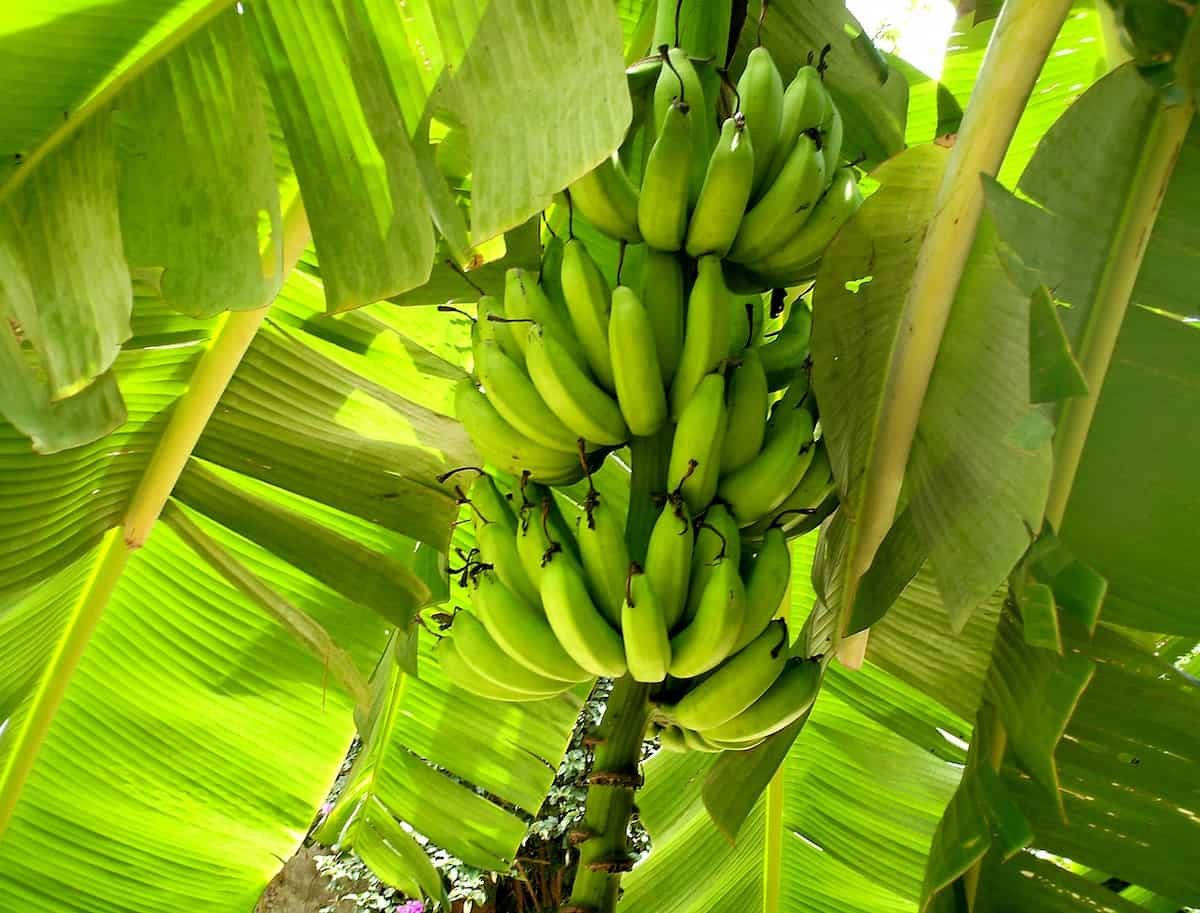
Irrigation requirements for Robusta crop
Irrigate immediately after planting; after four days, give life irrigation; subsequent irrigations are once a week for garden bananas and once in 10 – 15 days for wetlands. The fields should be irrigated copiously after every application of manure. The drip irrigation rate should be 5-10 liters/plant/day from planting to the 4th month, 10-15 liters/plant/day from the 5th to shooting, and 15 liters/plant/day from the shooting to 15 days before harvest.
The application of water-soluble or liquid fertilizers through drip irrigation (fertigation) avoids the loss of nutrients from conventional fertilizers, namely losses of N from leaching, volatilization, and evaporation, as well as losses of P and K from soil fixation. A 25-30% increase in yield is observed when fertigation is used. Additionally, it saves time and ensures uniform distribution of nutrients.
Drip irrigation scheduling in Robusta cultivation
| Crop growth stage | Duration (week) | Quantity of water (L/plant) |
| After Planting | 1-4 | 4 |
| Juvenile Phase | 5-9 | 8-10 |
| Critical Growth Stage | 10-19 | 12 |
| Flower bud differentiation Stage | 20-32 | 16-20 |
| Shooting Stage | 33-37 | 20 and above |
| Bunch Development Stage | 38-50 | 20 and above |
Bunch covering in Robusta banana cultivation
Covering bunches with gunny cloth or polythene protects the fruit from sunburn, hot wind, and dust. Covering of bunches is practiced in the Robusta bananas to get attractive colors. When used for bunch covering, perforated or polythene bags increased yield by 15-20 %. The peduncle of the bunch may be covered with the flag to prevent main stalk rot.
Intercropping in Robusta cultivation
Bananas have superficial roots that are easily damaged by cultivation. Therefore, intercropping is not recommended. Green manuring crops, however, include short-duration crops (45-60 days) such as mung, cowpea, and daincha. In addition, during the first 3-4 months, legumes, beetroot, elephant foot yam, ginger, turmeric, and sunn hemp can be grown as intercrops.
Cucurbitaceous vegetables, however, should be avoided because they carry viruses. Coconut and arecanut plantations with tall cultivars are grown in Karnataka, Kerala, and Andhra Pradesh coastal regions. Additionally, fruit trees like jack fruit and papaya are planted with the plantation to provide fruit and serve as windbreaks.
Majors pests in Robusta banana
Rhizome weevil
Symptoms of damage
- Grubs bore into the rhizome and cause the death of the plant
- Presence of dark-colored tunnels in the rhizomes.
- Death of unopened pipe, withering of outer leaves.
Control methods
- Debris that may harbor borers should be removed from plantations.
- Plantation floors are covered with 2-foot-long pieces of old rhizomes or pseudostems.
- These stems migrate adult beetles, which can be collected by hand and poisoned before planting by dipping suckers in Monocrotophos (0.5%) for 30 minutes.
In case you missed it: Grand Nain (G9) Banana Farming in India: A Cultivation Guide to Planting to Harvesting
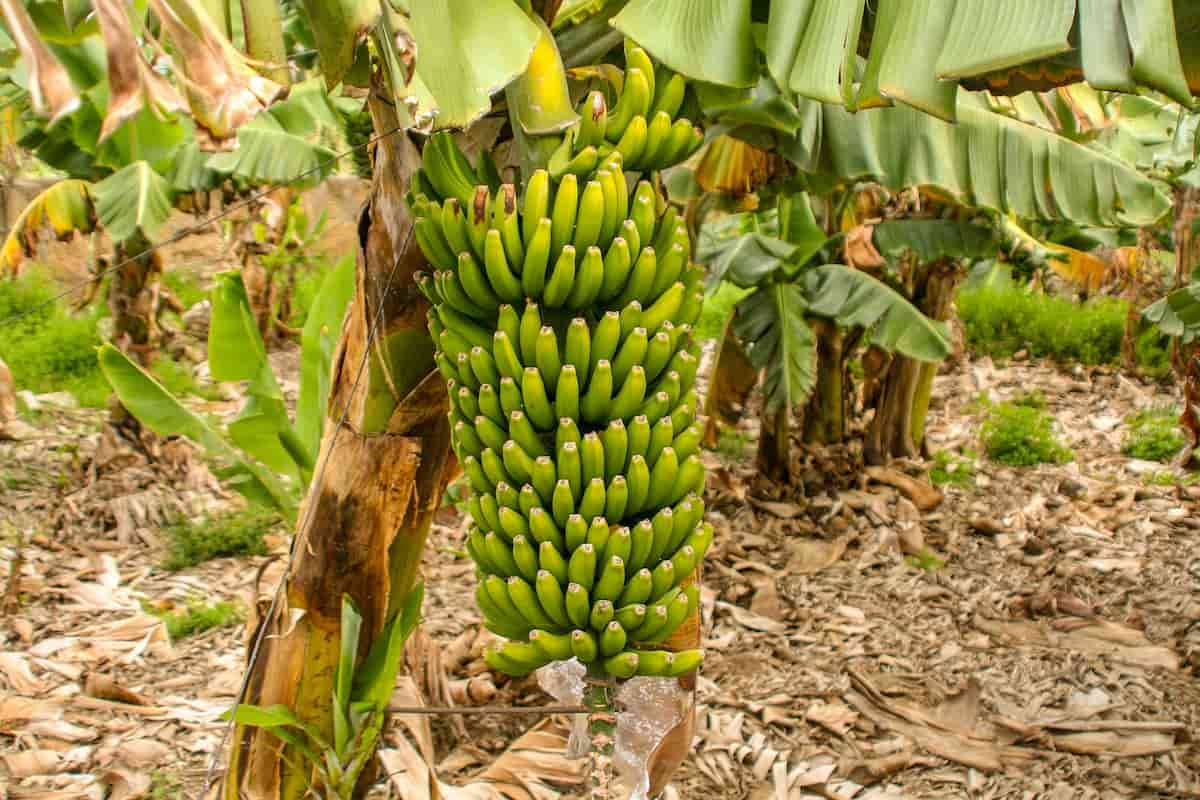
Banana aphid
Damage symptoms
- Leaves are bunched into a rosette appearance.
- Leaf margins are wavy and upward rolling.
- Do not produce bunches.
- It is the vector of bunchy top disease.
- Noticeable in colonies on leaf axils and pseudostem.
Control methods
- At 10-15 day intervals, spray Monocrotophos (0.05%) or Malathion (0.1%) to control aphid populations. A soil application of 1.0 kg a.i./ha of granular insecticide like Phorate will help prevent the recurrence of the pest.
- You can control it by spraying any of the following systemic insecticides. You can use Phosphamidon 2 ml/lit, Methyl Demeton 2 ml/lit, Monocrotophos 1 ml/lit, or Dimethoate 30 EC 2 ml/lit. At least thrice every 21 days, spray the crown and pseudostem base up to the ground level.
- It is very effective to inject Monocrotophos 36 WSC 1 ml/plant (1 ml diluted in 4 ml of water) at 45-day intervals from the third month until flowering. Monocrotophos should not be injected after flowering.
Banana stem weevil
Damage symptoms
- Rub bore into pseudostem, making tunnels.
- Tunneled part decomposes, and the pseudostem becomes weak.
- They also cut holes in the outer surface. Later, a blackened mass comes out from the borehole.
- Wilting of the plant.
Control methods
- Keep the plantation clean by removing dried leaves periodically. In addition, ensure that the suckers are pruned every month.
- Monocrotophos 36 WSC should be sprayed at a rate of 1 ml per liter of water.
- As an alternative, dilute 54 ml of Monocrotophos 36 WSC with 350 ml of water and inject 4 ml (2 ml at 45 cm from the ground level and another 2 ml at 150 cm from the ground level) into the pseudostem at a monthly interval from 5th to 8th month.
In case you missed it: Kashmiri Apple Cultivation in India: Farming Practices, Production Methods, and Yield
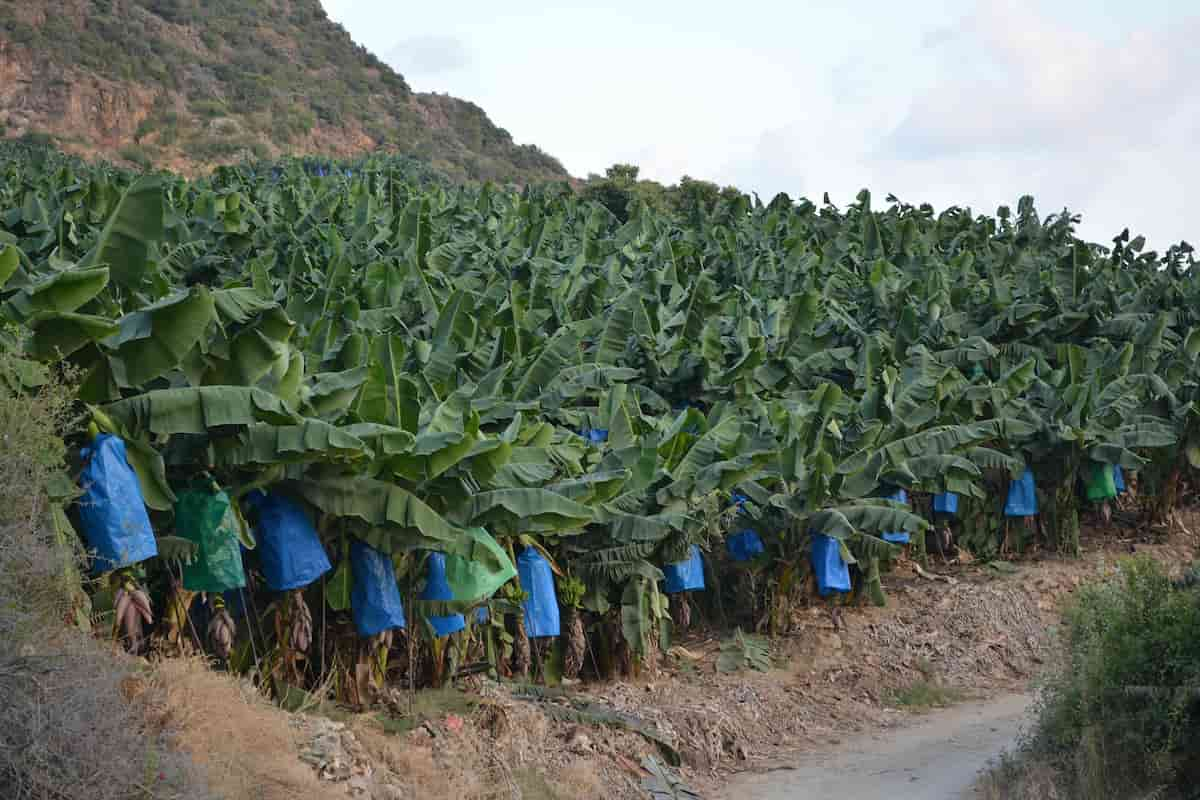
Major diseases in Robusta banana
Leaf Spot, Leaf Streak, or Sigatoka Disease
Disease symptoms
- Initial symptoms appear in the form of light yellowish spots on the leaves.
- A few of these enlarge and become oval; the color also changes to dark brown. Still later, the center of the spot dies, turning light grey and surrounded by a brown ring.
- In severe cases, numerous spots coalesce, killing large parts of the leaf. Rainfall, dew, and temperature determine the spread of the disease.
Control and management
- A foliar spray of Copper Oxychloride (3g/liter of water) or Thiophanate Methyl (1g/liter of water) effectively controls the disease.
- Infections are more likely to occur in poor drainage and waterlogging fields.
- Spray three times with Carbendazim 0.1 percent or Propicanozole 0.1 percent or Mancozeb 0.25% at 10-15 day intervals, as the disease starts when leaf spots appear.
Bunchy Top
Damage symptoms
- The disease spreads when suckers are planted that have been infected.
- Such infected suckers have narrow leaves that are chlorotic and exhibit mosaic symptoms. Furthermore, the margins of the affected leaves are rolled upward, making them brittle.
- Dark green streaks along secondary veins of the lamina or midrib of the petiole characterize clustery top virus. Infected plants remain stunted and produce no commercial value.
Control and Management
- Plant bananas with virus-free materials and remove infected plants, and rouge them
- For early detection of suckers, keep the field clean and weed-free
- Injecting 4 ml of the Fernoxone solution (50g in 400 ml of water) into the plants is recommended.
- For vector control, monocrotophos 4 ml (1:4) should be injected into plants every 45 days from the third month until flowering.
- Use of phosphomidon at 1ml per liter, methyldemeton at 2ml per liter, or Monocrotophos at 1ml per liter on plants
In case you missed it: Yelakki Banana Farming in India: Production and Cultivation Management Practices
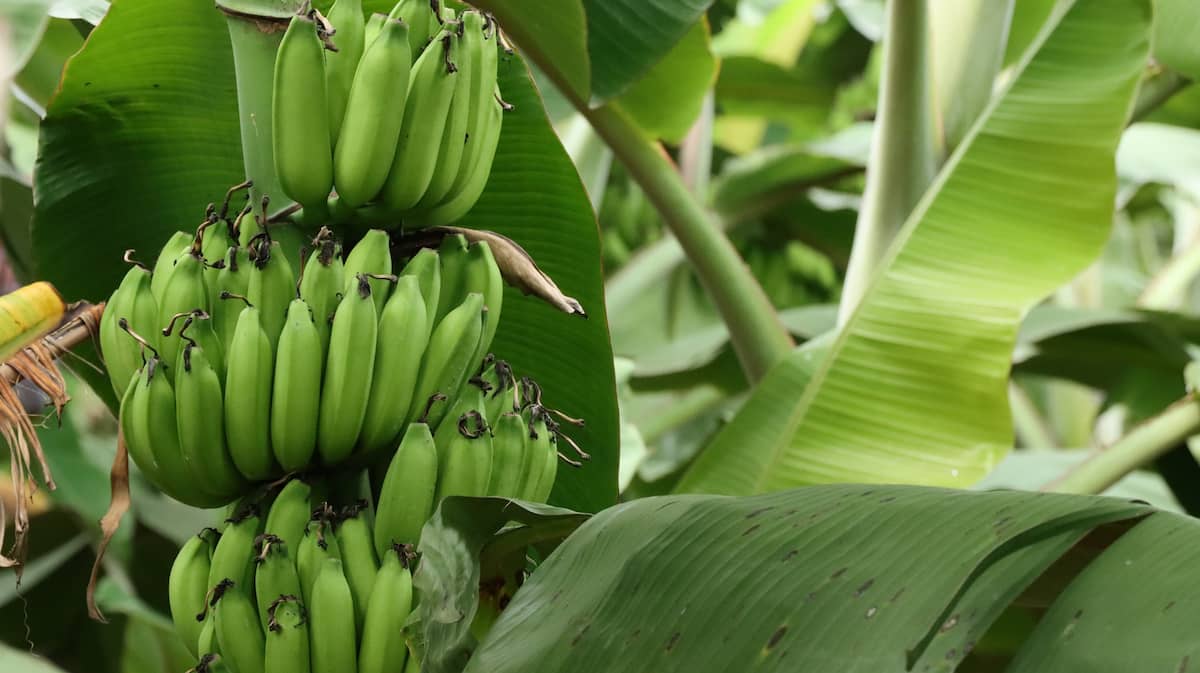
Erwinia rot
Damage Symptom:
- Young suckers are more susceptible to this disease, resulting in rotting and foul odors
- Rotting of the crown is a characteristic symptom followed by sudden drying of the leaves
- Plants that are affected are pulled out from the crown, leaving the corm with its roots in the soil
- Yellowish to reddish ooze can be seen when affected plants are cut open at the collar region
- Soft rotting may spread radially through cortical tissues toward the growing point. A foul odor emanates from rotten corms
Control and maagement
- Good drainage and soil conditioning can control the disease to some extent.
- Plant disease-free suckers.
- Remove infected plants immediately.
- Remove plant residues after harvest.
- Dip suckers in copper oxychloride (40g/10l)+ streptocycline (3g/10lit) for 30 min before planting
Harvesting
Depending on the market’s preference, bananas are harvested when they are slightly or fully mature. Harvesting is conducted at 75-80 percent maturity for long-distance transportation. Climacteric, the fruit is ready for consumption after the ripening process. After planting, bananas are ready for harvest within 12-15 months, and the main harvesting season is September to April.
After flowering, bouquets mature 90-150 days after flowering, depending on variety, soil, weather, and elevation. With a sharp sickle 30 cm above the first hand, harvest the bunch when the fingers of the second hand from the top are 3/4 rounded. The harvest may be delayed for up to 100-110 days after the opening of the first hand. Harvested bunches should be collected and brought to the collection site in well-padded trays or baskets.
Conclusion
The combination of tropical weather and humidity in India makes it an ideal location for banana production and different banana varieties. As a result, the Robusta Banana tree is one of the most important and commercially sold types of banana trees. Throughout the world, banana varieties and their immense health benefits have motivated people to consume bananas and know their importance.
- Types of Pesticides Used in Agriculture: A Beginner’s Guide
- Economical Aquaculture: A Guide to Low-Budget Fish Farming
- 15 Common Planting Errors That Can Doom Your Fruit Trees
- How to Make Houseplants Bushy: Effective Tips and Ideas
- Innovative Strategies for Boosting Coconut Pollination and Yield
- Pollination Strategies for Maximum Pumpkin Yield
- The Complete Guide to Chicken Fattening: Strategies for Maximum Growth
- Natural Solutions for Tulip Problems: 100% Effective Remedies for Leaf and Bulb-Related Issues
- Revolutionizing Citrus Preservation: Towards a Healthier, Greener Future
- Natural Solutions for Peony Leaf and Flower Problems: 100% Effective Remedies
- Maximizing Profits with Avocado Contract Farming in India: A Comprehensive Guide
- Natural Solutions for Hydrangea Problems: 100% Effective Remedies for Leaf and Flowers
- The Ultimate Guide to Choosing the Perfect Foliage Friend: Bringing Life Indoors
- From Sunlight to Sustainability: 15 Ways to Use Solar Technology in Agriculture
- The Ultimate Guide to Dong Tao Chicken: Exploring from History to Raising
- The Eco-Friendly Makeover: How to Convert Your Unused Swimming Pool into a Fish Pond
- Mastering the Art of Delaware Chicken Farming: Essentials for Healthy Backyard Flocks
- 20 Best Homemade Fertilizers for Money Plant: DIY Recipes and Application Methods
- How to Craft a Comprehensive Free-Range Chicken Farming Business Plan
- Brighten Your Flock: Raising Easter Egger Chickens for Beauty and Bounty
- How to Optimize Your Poultry Egg Farm Business Plan with These Strategies
- Subsidy for Spirulina Cultivation: How Indian Government Schemes Encouraging Spirulina Farmers
- Ultimate Guide to Raising Dominique Chickens: Breeding, Feeding, Egg-Production, and Care
- Mastering the Art of Raising Jersey Giant Chickens: Care, Feeding, and More
- Ultimate Guide to Raising Legbar Chickens: Breeding, Farming Practices, Diet, Egg-Production
- How to Raise Welsummer Chickens: A Comprehensive Guide for Beginners
- How to Protect Indoor Plants in Winter: A Comprehensive Guide
- Ultimate Guide to Grow Bag Gardening: Tips, Tricks, and Planting Ideas for Urban Gardeners
- Guide to Lotus Cultivation: How to Propagate, Plant, Grow, Care, Cost, and Profit
- Agriculture Drone Subsidy Scheme: Government Kisan Subsidy, License, and How to Apply Online
- Ultimate Guide to Raising Araucana Chickens: Breed Profile, Farming Economics, Diet, and Care
- Bringing Hydroponics to Classroom: Importance, Benefits of Learning for School Students
- Ultimate Guide to Raising Polish Chickens: Breed Profile, Farming Economics, Diet, and Care
- Ultimate Guide to Raising Australorp Chickens: Profile, Farming Economics, Egg Production, Diet, and Care
- Silkie Chicken Farming: Raising Practices, Varieties, Egg Production, Diet, and Care
- Sussex Chicken Farming: Raising Practices, Varieties, Egg Production, Diet and Care